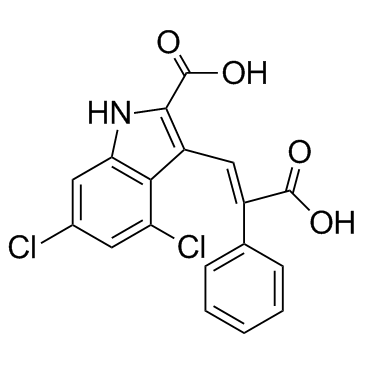| Description |
MDL 105519 is a potent and selective antagonist of glycine binding to the NMDA receptor.
|
| Related Catalog |
|
| In Vitro |
MDL 105519 is a potent and selective ligand for the glycine recognition site that completely inhibit the binding of [3H]glycine to rat brain membranes with a Ki value of 10.9 nM. MDL 105519 is approximately 10,000-fold selective for the glycine recognition site relative to the other receptor types investigated. MDL 105519 inhibits NMDA-dependent responses, such as elevations of [3H]TCP binding in brain membranes, cyclic GMP accumulation in brain slices, and alterations in cytosolic Ca2+ and Na+-Ca2+ currents in cultured neurons. Inhibition is non-competitive with respect to NMDA and could be nullified with D-serine[1].
|
| In Vivo |
MDL 105519 is an NMDA receptor antagonist in vivo. Intravenously administration of MDL 105519 prevents harmaline-stimulated increases in cerebellar cyclic GMP content, providing biochemical evidence of NMDA receptor antagonism in vivo. This antagonism is associated with anticonvulsant activity in genetically based, chemically induced, and electrically mediated seizure models. Anxiolytic activity is observed in the rat separation-induced vocalization model, but muscle-relaxant activity is apparent at lower doses. Higher doses impair rotorod performance, but are without effect on mesolimbic dopamine turnover or prepulse inhibition of the startle reflex[1].
|
| Animal Admin |
Adult, male, CD rats are administered MK-801 (n=4, 2 mg/kg, i.p.) or MDL 105519 (n=4, 2 mg/kg, i.p.) and extracellular dopamine concentrations are measured using in vivo microdialysis[1]. Mice: Mice adult male CD-1 are injected with various doses of MDL 105519 (8, 16, 32, 64, 128 mg/kg) intraperitoneally and 30 min later are administered harmaline 50 mg/kg. Sixty minutes after the first injection, the mice are killed and cerebellar cGMP content is measured by radioimmunoassay[1].
|
| References |
[1]. Baron BM, et al. Pharmacological characterization of MDL 105,519, an NMDA receptor glycine site antagonist. Eur J Pharmacol. 1997 Apr 4;323(2-3):181-92.
|
